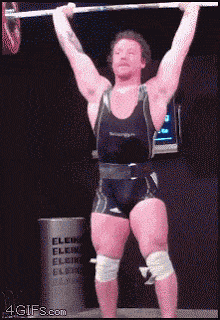I'M ALWAYS TRYING TO FIGURE OUT NEW WAYS TO IMPROVE MY RESULTS WITH CLIENTS. During my first two years as a trainer, I felt a little powerless with some clients.
I told them all the right things. Reduce carbohydrates, eat more protein and veggies with every meal, strength train. The thing is, a lot of my clients didn't make much progress.
Every week I would take their measurements but still no change. I'm sure you know the feeling. It's frustrating as hell. They were just "bad clients." I would slowly get rid of them and work with people who actually wanted to change, not time wasters.
As a fitness professional you have to realize that you're an outlier. We are the minority. I remember my first day of my exercise science degree my lecturer called us all "freaks."
Why you ask?
Most people don't look forward to hitting the gym first thing in the morning or doing mobility work during free time. They're not like us. So why then do we as an industry act a like we're training fellow trainers? Someone who puts fitness and nutrition above everything else in their lives?
Once I opened my eyes I realized that they weren't bad clients. I was just a bad trainer. It wasn't that they weren't getting it. It was that I was speaking to them at my level, not theirs.
If you want to be more than just another rep counting trainer it's time to start helping clients build habits and change behaviors.

1. Meaning
Find out what exercise means to your client.
- Do they have a negative association due to past experiences?
- Is it that thing that makes them feel insecure and inadequate?
- That thing that makes them feel embarrassed?
When we know the meaning our clients associate with exercise, we can work with them and change that meaning into something positive.
The key here is that our clients are in control. Just think of the angry teenager who does the exact opposite to what her parents asks her to do. A client who is constantly told what to do rebels in the same way.
When we get clients to know their "why" behind exercise, the process shifts from something they should be doing to an autonomous decision where they've taken responsibility for their own actions.
In No Sweat, author Michelle Seger outlined a study that proved how important having the right meaning is.
The study found that 75% of people interviewed exercised to "lose weight" or "be healthy." The remaining 25% exercised to "feel good." The study found that the first group, the ones who felt they had to exercise actually exercised 32% less than other groups.
This is where you as a coach come in. Helping your client find the right why for exercise is the difference between exercise becoming a gift instead of a chore.
From Jon: I've written an article that goes into more depth into this point. If you're interested in why smart trainers often set stupid goals, click the link below to open the article in a new window to read after:
--> Why Smart Trainers Often Set Stupid Goals
2. Change Exercise from a Chore to a Gift
Earlier this month I started meditating for one hour in the morning. This was a practice I had been doing up until May but due to work commitments had to cut it back to 15 minutes.
The first week was horrible. When I woke up it felt like I had this huge chore ahead of me. I wasn't enjoying it and spent the whole time waiting for it to finish. Of course my meditation practice suffered because of this. I considered stopping for a while because there was zero enjoyment.
In week two I made two changes. First, instead of looking at it as this arduous task I reframed it. I was giving myself a gift that would give me more energy and make me more present to my loved ones.
Next I used what is called "reward substitution." The benefits of meditation are fantastic but they can take some time to enjoy. So if I did one hour in the morning I would reward myself that night with an episode of Narcos. This was something that I could enjoy on the same day as I completed the task at hand.
Reward substitution is a powerful coaching tool to use with clients because we're hard wired to choose instant gratification no matter how good the long-term pay off is.
Food marketers have known this for a long time. Fast food is a perfect example of something that involves almost no effort. You drive up, place your order and five minutes later you're eating. Instant gratification.
We need to use this to our advantage and educate clients that they don't need to do a 60-minute workout for exercise to count. When it comes to movement, everything counts.
3. Opportunities to Move (OTM)
I love this point. It's something that's helped improve my own mobility 10 fold.
I first started practicing OTM when I followed Ido Portal's 30/30 squat challenge. You hold a third world squat for 30 minutes a day for 30 days.
The results shocked me. I improved my squat more in that block of time than I had in the previous 2 years. It worked wonders for me again when I wanted to improve my downward dog position in Yoga.
My teacher recommended hanging out in downward dog throughout the day, 10 seconds here, 30 seconds there. Again it had a huge impact on my technique.
With your clients you can challenge them to see how many OTM's they can find throughout the day.
- Park farther away from the store
- Add 5 minutes to walk
- Walk when on the phone
- Have walking meetings
- Use a standing desk
- Dancing in the kitchen
Now the excuse of not having time goes out the window. Clients begin to see that every situation is an opportunity to move.

4. Self Care
We all know people who "just don't have the time" for themselves. Lets take a former clients of mine named Ann. She had a full time job and a toddler at home.
Ann never had time for anything and was always chasing the day. It took a lot of coaching but eventually Ann began to understand that when she put herself first she had more energy to help the people around her.
When coaching clients about "self care," we work with the client to find what things result in them performing optimally. Simply ask the client,
"What one thing if neglected will result in your day being more difficult?"
Sleep was Ann's non-negotiable self-care behavior. Once I knew this it was easier to know what to focus on.
"The self-care paradox reflects the idea that the more energy you give to caring for yourself, the more energy you have to give to and fuel what matters most in your life"
- Michelle Seger
5. Having a Learning Mindset
When we teach clients that there is no such thing is failure, intrinsic motivation and persistence follow.
All information is looked at as data to learn from. Not good or bad. Just data that we'll use and learn from each time. So as the weeks go by there's no such thing as failing. It's about seeing what is working and what isn't working and tweaking it.
Your client is a scientist studying their body and building awareness along the way. With the learning mindset clients start to take responsibility for their health and it's no longer something outside of their control.
Wrap up
Habit formation and behavioral change is what we as exercise professionals need to be investing more time and energy into, not programming.
The general population needs more coaching in how to implement healthy habits into their lives and less help counting reps.









